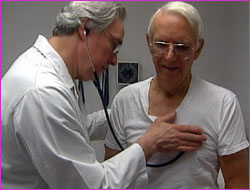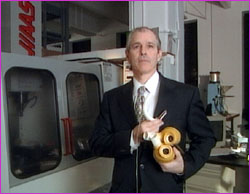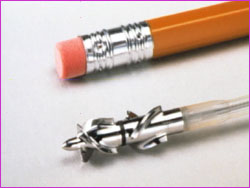
|
 |
|
O. H. Frazier Dr. O. H. Frazier has done more heart transplants and more implants of left ventricular assist devices than anyone else. Chief of Cardiopulmonary Transplantation at the Texas Heart Institute in Houston, Frazier also stands in the vanguard of researchers testing various partial and total artificial hearts, in hopes of saving the lives of the hundreds of thousands of people in the U.S. who die every year from coronary heart disease. Here he talks with NOVA producer Sarah Holt about everything from the early Jarvik-7 artificial heart (the one implanted in Barney Clark, who in 1982 became the first recipient of a permanent artificial heart) to the new AbioCor total artificial heart, the first that will be completely enclosed within the body. NOVA: Will the heart be the first organ that we succeed in replacing? Frazier: As far as an internal organ that we can replace, the heart certainly seems to be the organ that will be first. Some research is ongoing with both livers and lungs, but that technology is very early in development. The heart is still a complicated organ to replace (much more than a simple pump) but the technology is better developed. The heart has many properties, including hormonal properties, that we never appreciated when we first started doing this research. In the near future, I think that the heart will be the only organ that will be replaced as a totally artificial or man-made substitute for an internal human organ. NOVA: And why is that so important? Frazier: It's important from a lot of standpoints. Too many patients die prematurely. Today, if an active working person in his or her 70s dies from a heart attack, that death is premature. The main cause of premature death in the U.S. and the world is heart disease. Even though we smoke less, eat more healthful foods, and exercise, the incidence of heart disease has not decreased. If anything, it seems to be increasing. In addition, heart disease is a very common cause of death in women as well as men—in fact, heart disease causes death in more women under the age of 60 than breast cancer does—and it also plagues children and young adults. NOVA: Heart transplantation is not enough? Frazier: Heart transplants were a remarkable advance. I have the dubious honor of probably doing more than anyone, because I'm the only one at our center who does transplant operations. I've done over 700 heart transplants, but I have very mixed feelings about it. Heart transplantation is a wonderful technology, and it helps patients, but it's a rather temporary solution. All of us in the field have been rather discouraged by the limitations of long-term survival, particularly in our young patients.
It's the same for the young adults. I have patients 25 or 30 years old. They appreciate living another eight to ten years. But they want more, and we want more. Probably the most emotionally satisfying patients we do heart transplants for are those in their 60s, because they are more satisfied with the additional time, which is enough to get them their three score and ten. NOVA: Aren't there only about 2,000 hearts available for transplant every year? Frazier: Yes, and that number has gone down instead of up. We have fewer homicides, fewer automobile accidents. The helmet laws have made a significant difference in the number of motorcycle fatalities. In the 1980s, hardly a week went by without our seeing a donor who had been killed on a motorcycle. We haven't seen that in years. This is good, actually. After all, it's rather disquieting to have to depend on the misfortune of others for these patients to benefit. In addition, many of the donors we do have are older and more compromised than in previous years. Also, the cost of heart transplantation is enormous, and there's no way of lessening the cost. A heart transplant requires a team of people in the operating room and a large team of people to take care of these patients after their transplant. For all of these reasons, it's very important that research into artificial hearts continues. NOVA: What are your thoughts on the Jarvik-7 artificial heart?
Most of us doing research in the field of artificial hearts were not optimistic about the use of the Jarvik-7 heart as permanent therapy. The calf experiments with the Jarvik-7 showed limited survival. There were frequent problems with infections, with durability, and with strokes or blood clots. So we were a bit skeptical of the outcome. I think there were even some public statements made to that effect by both Dr. [Michael] DeBakey and Dr. [Denton] Cooley at the time this trial began. But the remarkable thing about that trial was really how well the patients did. All of the patients were dying, and the pump lasted far longer and had far fewer problems than we had anticipated. Of course, all those patients had a lot of spirit and courage as well. We were encouraged by that, because the device was loud and bulky and actually rather traumatic with its forceful pumping. We thought that these problems might be difficult for the patients to accept, but they seemed to accept them very well. NOVA: So a lot was learned from the Jarvik-7? Frazier: Yes. I think all of us in the field were stunned because the heart worked so well. I saw those patients, and it was absolutely remarkable that they lived as long as they did. One survived about 600 days. I don't think any of the LVADs have lasted much longer. [LVADs are left ventricular assist devices—partial artificial hearts that take over pumping blood for the left ventricle.] That showed the durability of the human body and the human spirit. NOVA: Yet after Jarvik-7, didn't many researchers in the field begin focusing strictly on developing LVADs?
NOVA: A real breakthrough in developing LVADs came in 1988 with Richard Wampler's axial-flow pump [a tiny, continuous-flow pump that allows weakened hearts to recover]. Did that pave the way for the new continuous-flow LVADs like the Jarvik-2000 and the DeBakey VAD? Frazier: Yes, it really opened up this field. Wampler designed it for use as a temporary pump: a very small, continuous-flow pump that would take the blood out of the heart when the heart failed after a sudden heart attack or right after heart surgery, and pump for a few days to allow the heart to rest. Our first use of the Hemopump in April 1988 was very dramatic because it showed us that patients could live without a pulse. I had one little boy who lived for about three days without a pulse at all. He was very small, and this tiny pump could take over his entire circulation. He woke up, he ate popsicles, and he did very well for a period of time until his heart had recovered enough to start beating again. With the Hemopump, we also learned that we could have a very high rate of flow and turbulence in the bloodstream without destroying the blood cells, which was a very important finding. That stimulated others to develop continuous-flow pumps. Continue: The advantages of continuous flow Map of the Human Heart | Amazing Heart Facts The Artificial Human | Pioneering Surgeon | Operation: Heart Transplant Resources | Transcript | Site Map | Electric Heart Home Editor's Picks | Previous Sites | Join Us/E-mail | TV/Web Schedule About NOVA | Teachers | Site Map | Shop | Jobs | Search | To print PBS Online | NOVA Online | WGBH © | Updated November 2000 |
 Heart surgeon O. H. Frazier
Heart surgeon O. H. Frazier
 Frazier has done more heart transplants than anyone
else.
Frazier has done more heart transplants than anyone
else.
 The Jarvik-7, here held by its designer, Robert
Jarvik, was the first total artificial heart to be
implanted in a patient.
The Jarvik-7, here held by its designer, Robert
Jarvik, was the first total artificial heart to be
implanted in a patient.
 Axial-flow pumps are tiny enough to fit inside the
human heart.
Axial-flow pumps are tiny enough to fit inside the
human heart.